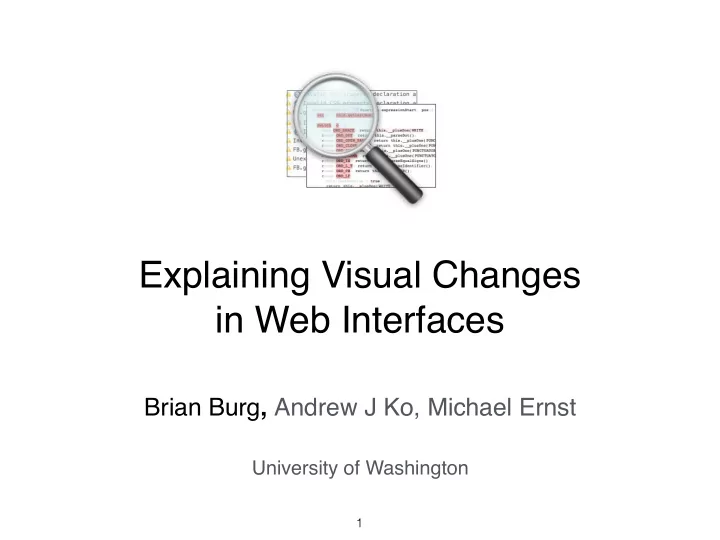

Explaining Visual Changes in Web Interfaces Brian Burg , Andrew J Ko, Michael Ernst University of Washington 1
2
Feature Location Feature location is the activity of identifying an initial location in the source code that implements functionality in a software system. Dit, B., Revelle, M., Gethers, M., and Poshyvanyk, D., "Feature Location in Source Code: A Taxonomy and Survey", Journal of Software: Evolution and Process (JSEP), vol. 25, no. 1, January 2013, pp. 53–95 3
Feature Location for Interactive Web Content 4
How can I interact with it? Visual Output 😅 5
How is the visual effect achieved? DOM & CSS Visual Output 🤕 😅 6
What code is ultimately responsible? JavaScript DOM & CSS Visual Output 😨 🤕 😅 7
JavaScript DOM & CSS Visual Output No Links Between Scattered State No Output History Source and State 8
Scry Staged, Interactive Feature Location 9
Staged, Interactive Feature Location Output Examples 10
Staged, Interactive Feature Location Δ ( pre, post ) Output Examples State Differences 11
Staged, Interactive Feature Location Δ ( pre, post ) Output Examples State Differences JavaScript Mutations 12
Δ ( pre, post ) Output Examples State Differences JavaScript Mutations 15
What determines visual appearance? DOM Tree Structure Rendering Engine Visual State CSS Style Properties Color, layout mode, visual styling, text rendering, handling of children 16
Target Element Snapshots DOM Subtree Element Screenshots Computed Styles & Mutation Operations Related Rules 17
Why does visual appearance change? DOM Tree Mutations Style Property Changes Rule Changes Inline Styles Animations Insertion Deletion class=“active” textContent = … :hover, :focus Ordinal Change Attributes & States 18
Detecting changes in appearance Painted Rects YES YES Do they Visual Diff Commit New intersect? >1%? Snapshot NO NO Snapshot of Target Element 19
Comparing Δ ( pre, post ) State Snapshots Per-element change summaries Structure: Insertion, Deletion, Attributes, … Styles: Added, Removed, Value Change Relies on stable DOM element identity Doesn’t work well when view state is split from DOM 20
Change-Relevant Operation Slicing 1. Instrument and record mutation operations. 2. Build a dependency graph for operations between the pre-state and post-state. 3. Based on change summary, find an equivalent mutation operation to explain the change. 4. Return equivalent operation + dependencies
Technical Challenges Visual containment, stacking Software vs hardware rendering Unstable DOM element identities Megamorphic call sites in library code Pruning ine ff ective styles and attributes 22
Summary Feature Location via Visual States States can be automatically captured when drawing. Juxtapose Captured Inputs and Outputs State and output snapshots help explain each other. Diff Markers Filter Relevant Operations Slicing algorithms can show responsible operations. 23
Explaining Visual Changes in Web Interfaces Brian Burg , Andrew J Ko, Michael Ernst University of Washington 24
Recommend
More recommend